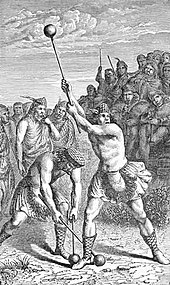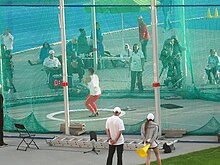
A | B | C | D | E | F | G | H | CH | I | J | K | L | M | N | O | P | Q | R | S | T | U | V | W | X | Y | Z | 0 | 1 | 2 | 3 | 4 | 5 | 6 | 7 | 8 | 9
| Athletics Hammer throw | |
|---|---|
 | |
| World records | |
| Men | |
| Women | |
| Olympic records | |
| Men | |
| Women | |
| World Championship records | |
| Men | |
| Women | |

The hammer throw is one of the four throwing events in regular outdoor track and field competitions, along with the discus throw, shot put and javelin.
The "hammer" used in this sport is not like any of the tools also called by that name. It consists of a metal ball attached by a steel wire to a grip. These three components are each separate and can move independently. Both the size and weight of the ball vary between men's and women's events. The women's hammer weighs 4 kilograms (8.8 lb) for college and professional meets while the men's hammer weighs 7.26 kilograms (16.0 lb).[1]
History


The exact origins of the hammer throw are a mystery to modern historians.[citation needed] According to legend, at the Tailteann Games in Tara, Ireland, as far back as 2000 BC the Celtic warrior Culchulainn took a chariot axle with a wheel still attached and spun it around and hurled it.[2] The wheel was later replaced by a rock with a wooden handle attached.[2] A sledgehammer began to be used for the sport in Scotland and England during the Middle Ages.[2] In current times, the hammer has changed to the more modern 7.26 kg ball attached to a wire and a handle, but the Scottish Highland Games still feature the older style of hammer throw with the rock and the solid wood handle. Today the Hammer throw is one of four throwing events featured in the Olympics alongside discus, shot put, and javelin.

While the men's hammer throw has been part of the Olympics since 1900, the International Association of Athletics Federations did not start ratifying women's marks until 1995. Women's hammer throw was first included in the Olympics at the 2000 summer games in Sydney, Australia, after having been included in the World Championships a year earlier.[citation needed]

Competition
The men's hammer weighs 16 pounds (7.26 kg) and measures 3 feet 11+3⁄4 inches (121.3 cm) in length, and the women's hammer weighs 4 kg (8.82 lb) and 3 ft 11 in (119.4 cm) in length.[3] Like the other throwing events, the competition is decided by who can throw the implement the farthest.
The throwing motion starts with the thrower swinging the hammer back-and-forth about two times to generate momentum. The thrower then makes three, four or (rarely) five full rotations using a complex heel-toe foot movement, spinning the hammer in a circular path and increasing its angular velocity with each rotation. Rather than spinning the hammer horizontally, it is instead spun in a plane that angles up towards the direction in which it will be launched. The thrower releases the hammer as its velocity is upward and toward the target.[4]

Throws are made from a throwing circle. The thrower is not allowed to step outside the throwing circle before the hammer has landed and may only enter and exit from the rear of the throwing circle. The hammer must land within a 34.92º throwing sector that is centered on the throwing circle. The sector angle was chosen because it provides a sector whose bounds are easy to measure and lay out on a field (10 metres out from the center of the ring, 6 metres across).[5][6] A violation of the rules results in a foul and the throw not being counted.[citation needed]
As of 2023[update] the men's hammer world record is held by Yuriy Sedykh, who threw 86.74 m (284 ft 6+3⁄4 in) at the 1986 European Athletics Championships in Stuttgart, West Germany on 30 August. The world record for the women's hammer is held by Anita Włodarczyk, who threw 82.98 m (272 ft 2+3⁄4 in) during the Kamila Skolimowska Memorial on 28 August 2016.[citation needed] Sedykh's 1986 world record has been noted for its longevity, and for dating from "a time when track and field was starting to realize the scale of performance-enhancing drug use" (AP).[7] According to Russian doping whistleblower Grigory Rodchenkov, Sedykh was a heavy user of steroids, which Sedykh denied.[7]
The throwing distance depends on the velocity and height at which the hammer is released, but also on other factors that are not under the athlete's control.[8] In particular, Earth's rotation affects it via the location's latitude (due to the centrifugal force, the hammer will fly a bit further in a location closer to the equator) and to a lesser extent also via the throw's azimuth (i.e. its compass direction, due to Coriolis forces).[8] According to a 2023 study, such effects are large enough that the top 20 world-record rankings for both men and women at the time could somewhat change if they were adjusted for latitude and azimuth.[8]
Safety issues
Hammer throwing has been described as involving "inherent danger . Athletes, coaches, and spectators participating in the event are at risk; steel hammers are hurled through the air at great speeds, far distances, and sometimes difficult to spot in flight."[9] For example, hammer throws resulted in four deaths in Europe in 2000 alone,[10] and have caused deaths and permanent brain damage injuries in the United States too.[9]
To mitigate such risks, a C-shaped "hammer cage" was introduced, which is built around the throwing circle, preventing the hammer from flying off in unwanted directions.[9] In 2004, the IAAF changed its rules to increase the mandatory height of hammer cages to 10m and reduce their "danger zone" angle to around 53°.[9] The change also moved the cage gates further away from the throwing circle, thus reducing the risk of a misdirected hammer bouncing back on the thrower.[11]
All-time top 25
Men
- Correct as of April 2024.[12]
| Ath.# | Perf.# | Mark | Athlete | Nation | Date | Place | Ref. |
|---|---|---|---|---|---|---|---|
| 1 | 1 | 86.74 m (284 ft 6 in) | Yuriy Sedykh | 30 August 1986 | Stuttgart | ||
| 2 | 86.66 m (284 ft 3 in) | Sedykh #2 | 22 June 1986 | Tallinn | |||
| 3 | 86.34 m (283 ft 3 in) | Sedykh #3 | 3 July 1984 | Cork | |||
| 2 | 4 | 86.04 m (282 ft 3 in) | Sergey Litvinov | 3 July 1986 | Dresden | ||
| 5 | 85.74 m (281 ft 3 in) | Litvinov #2 | 30 August 1986 | Stuttgart | |||
| 6 | 85.68 m (281 ft 1 in) | Sedykh #4 | 11 August 1986 | Budapest | |||
| 7 | 85.60 m (280 ft 10 in) | Sedykh #5 | 13 July 1984 | London | |||
| Sedykh #6 | 17 August 1984 | Moscow | |||||
| 9 | 85.20 m (279 ft 6 in) | Litvinov #3 | 3 July 1984 | Cork | |||
| 10 | 85.14 m (279 ft 3 in) | Litvinov #4 | 11 July 1986 | London | |||
| Sedykh #7 | 4 September 1988 | Moscow | |||||
| 12 | 85.02 m (278 ft 11 in) | Sedykh #8 | 20 August 1984 | Budapest | |||
| 13 | 84.92 m (278 ft 7 in) | Sedykh #9 | 3 July 1986 | Dresden | |||
| 3 | 14 | 84.90 m (278 ft 6 in) | Vadim Devyatovskiy | 21 July 2005 | Minsk | ||
| 15 | 84.88 m (278 ft 5 in) | Litvinov #5 | 10 September 1986 | Rome | |||
| 4 | 16 | 84.86 m (278 ft 4 in) | Koji Murofushi | 29 June 2003 | Prague | ||
| 17 | 84.80 m (278 ft 2 in) | Litvinov #6 | 26 September 1988 | Seoul | |||
| 18 | 84.72 m (277 ft 11 in) | Sedykh #10 | 9 July 1986 | Moscow | |||
| 19 | 84.64 m (277 ft 8 in) | Litvinov #7 | 9 July 1986 | Moscow | |||
| 5 | 20 | 84.62 m (277 ft 7 in) | Igor Astapkovich | 6 June 1992 | Seville | ||
| 21 | 84.60 m (277 ft 6 in) | Sedykh #11 | 14 September 1984 | Tokyo | |||
| 22 | 84.58 m (277 ft 5 in) | Sedykh #12 | 8 June 1986 | Leningrad | |||
| 6 | 23 | 84.51 m (277 ft 3 in) | Ivan Tsikhan | 9 July 2008 | Grodno | ||
| 7 | 24 | 84.48 m (277 ft 1 in) | Igor Nikulin | 12 July 1990 | Lausanne | ||
| 25 | 84.46 m (277 ft 1 in) | Sedykh #13 | 14 September 1988 | Vladivostok | |||
| Tsikhan #2 | 7 May 2004 | Minsk | |||||
| 8 | 84.40 m (276 ft 10 in) | Jüri Tamm | 9 September 1984 | Banská Bystrica | |||
| 9 | 84.38 m (276 ft 10 in) | Ethan Katzberg | 20 April 2024 | Nairobi | [13] | ||
| 10 | 84.19 m (276 ft 2 in) | Adrián Annus | 10 August 2003 | Szombathely | |||
| 11 | 83.93 m (275 ft 4 in) | Paweł Fajdek | 9 August 2015 | Szczecin | [14] | ||
| 12 | 83.68 m (274 ft 6 in) | Tibor Gécsek | 19 September 1998 | Zalaegerszeg | |||
| 13 | 83.46 m (273 ft 9 in) | Andrey Abduvaliyev | 26 May 1990 | Adler | |||
| 14 | 83.43 m (273 ft 8 in) | Aleksey Zagornyi | 10 February 2002 | Adler | |||
| 15 | 83.40 m (273 ft 7 in) | Ralf Haber | 16 May 1988 | Athens | |||
| 16 | 83.38 m (273 ft 6 in) | Szymon Ziółkowski | 5 August 2001 | Edmonton | |||
| 17 | 83.30 m (273 ft 3 in) | Olli-Pekka Karjalainen | 14 July 2004 | Lahti | |||
| 18 | 83.04 m (272 ft 5 in) | Heinz Weis | 29 June 1997 | Frankfurt | |||
| 19 | 83.00 m (272 ft 3 in) | Balázs Kiss | 4 June 1998 | Saint-Denis | |||
| 20 | 82.78 m (271 ft 7 in) | Karsten Kobs | 26 June 1999 | Dortmund | |||
| 21 | 82.71 m (271 ft 4 in) | Rudy Winkler | 20 June 2021 | Eugene | [15] | ||
| 22 | 82.69 m (271 ft 3 in) | Krisztián Pars | 16 August 2014 | Zürich | |||
| 23 | 82.64 m (271 ft 1 in) | Günther Rodehau | 3 August 1985 | Dresden | |||
| 24 | 82.62 m (271 ft 0 in) | Sergey Kirmasov | 30 May 1998 | Bryansk | |||
| Andriy Skvaruk | 27 April 2002 | Kyiv |
Annulled marks
- Ivan Tsikhan of Belarus also threw 86.73 in Brest on 3 July 2005. This performance was annulled due to doping offences.
Women
- Correct as of May 2024.[16]
